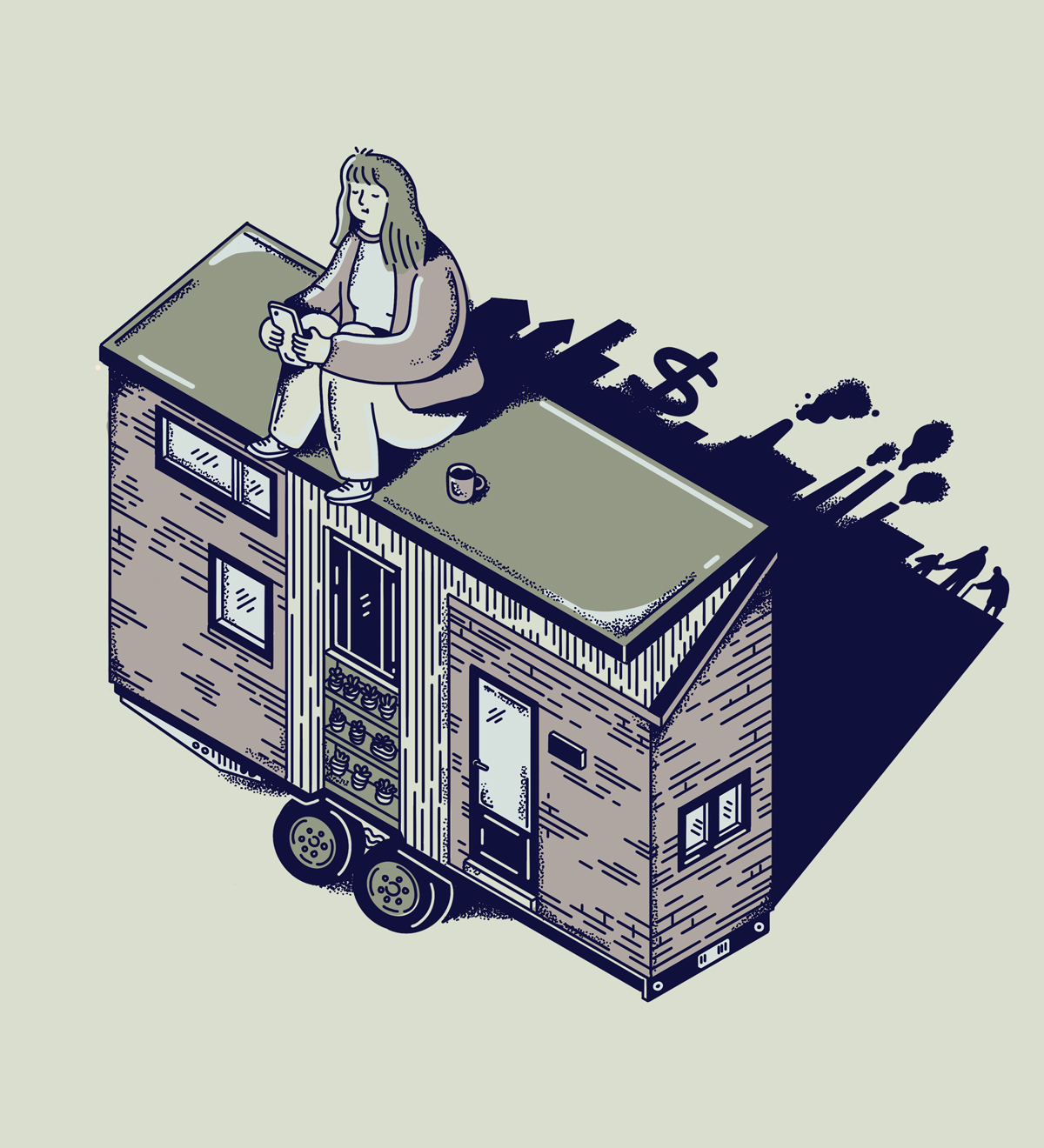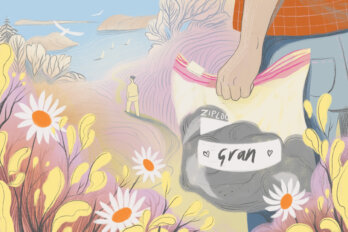In 1845, American writer Henry David Thoreau left his family home, in Concord, Massachusetts, to undertake a now famous experiment: build a cabin in the woods, move in, and live there, alone, for an extended period of time. That period—which added up to two years and two months—served as the basis for Walden: Or, Life in the Woods, a blend of memoir and philosophical treatise that turned Thoreau into a patron saint of self-sufficiency.
Since the book’s publication, facts have emerged about Thoreau’s stay at Walden Pond that contradict this image of solitude: he built his cabin on his friend Ralph Waldo Emerson’s land and he would regularly go home for dinner. (He also wasn’t particularly alone, being based in a part of the woods near a busy train track.) But the original impulse behind Walden persists even today: when it comes to our housing, doing more with less can generate a kind of freedom.
Thoreau’s project took place in the aftermath of the Panic of 1837, a financial crisis that touched off a particularly bad depression: economic activity declined sharply and US banks entered into what academic Alasdair Roberts calls a “paralysis of credit.” All around him, Thoreau may have seen farmers being pushed off their land and driven into poverty when they couldn’t pay their debts. It’s unclear whether he was tuned in to the national implications of economic policy, but he certainly had thoughts about what he saw playing out: he decried his contemporaries for “always promising to pay, promising to pay, tomorrow, and dying today, insolvent.” He also needled his readership for its bad credit habits: “I have no doubt that some of you who read this book are unable to pay for all the dinners which you have actually eaten, or for the coats and shoes which are fast wearing or are already worn out.” The solution, Thoreau insisted, was to simplify one’s life. In his case: Why pledge yourself to a mortgage when you could build your own home in the woods? Or simply find a large box, Thoreau suggests, drill a few holes in it for air, and a man can crawl inside “and in his soul be free.”
Almost 200 years later, we’re still telling ourselves that sleeping in a box is the epitome of freedom. Thoreau has been touted as an inspiration for the modern-day Tiny House Movement, a social and design ethos that champions living simply and very, very small. While there is some variance in what qualifies as “tiny,” these houses are usually less than 400 square feet and often built by the owners themselves. The dwellings flaunt Pinterest-savvy aesthetics: wood-panelled walls, cozy quilts, and well-placed plants on minimalist shelving—usually closer to “glamping” than to roughing it in the woods.
More than just a design trend, tiny living has become a social movement. It emphasizes individual agency, free-market ingenuity, and private ownership—often as false correctives to the bigger problems of housing insecurity and inequality. It’s an unfortunate legacy of Thoreau’s experiment, but in our current moment, its popularity makes sense. The promise of doing more with less is particularly bewitching in the context of a recession, where choice and economic freedom are in short supply. But our housing challenges are far too complex to be solved by individual consumer choices, like building a shed in the woods. As we look down the barrel of record government deficits and environmental catastrophe, we should be skeptical of the tiny house as a full-blown solution to our housing problems. More likely, the resurgence of tiny living is a symptom of the situation’s severity.
Like Thoreau’s sojourn at Walden Pond, the Tiny House Movement reached full steam in the aftermath of a recession—in this case, the Great Recession of the late 2000s, prompted by the subprime mortgage crisis in the US. In the early 2000s, American financial institutions lowered their credit standards and profited from a growing demand for housing. Potential homebuyers saw taking on bad or risky loans as a way to build wealth in the short term. The recession hit poor and overleveraged borrowers the hardest, and the crisis generated a lasting economic anxiety around banks, mortgages, and debts, in particular for young people. It is in this context that tiny-house adherents envision their solution: choosing to pursue simplicity by living with less.
As a lifestyle, its features are tremendously appealing: a lower cost of living, more environmentally conscious habits, and most importantly, the promise of living mortgage and debt free. This last point is crucial, as carving out an independent financial existence is a core tenet of tiny living. For Ryan Mitchell, owner and managing editor of the website The Tiny Life, this pursuit of self-sufficiency becomes an entire philosophy. The site posits “the freedom that accompanies the tiny house lifestyle” as the centrepiece of this small, curated existence. Whether it’s liberation from debt, from the misery of urban spaces, or from a cluttered home full of useless commodities, tiny living offers a way to transcend life’s material limitations—and reinforces the homeowner’s sense of being an intrepid, independent individual.
But the rugged individualism of the movement conceals the violent social relations that have made property ownership possible. Rebutting this individualist ethos in Jacobin magazine, Arielle Milkman offers a thorough, scathing account of what she calls “the tiny house fantasy.” That fantasy imagines that the solution to a nation’s housing crisis lies with the individual as opposed to with collective action and broad-based social change. For Milkman, this dream “rests on visions of property and expansion embedded in the American consciousness for more than a century”—an ethos that champions conquest, settlement, and property ownership as moral virtues even though they constitute the destruction of the natural world and violent theft from Indigenous peoples.
Moreover, this version of tiny living is a poor solution to the immense problem of housing justice. Though it sells itself as a more affordable path to home ownership, tiny living is financially inaccessible for large swaths of the population—the cost of building these dwellings can range from $10,000 to more than $100,000, and that’s before factoring in the price of land. Living on this scale becomes significantly harder, if not impossible, for families with children or other multigenerational households. Outfitting a miniscule space for people with accessibility needs (for example, a shower seat or a lift to access a loft bed) adds additional costs and challenges. The imagined owners of tiny homes, in other words, are likely childless and able-bodied, and they likely have at least ten grand to spare (plus, perhaps, the time or resources to build a home) and minimal familial responsibilities. If housing justice is truly our goal, then tiny living leaves a large contingent of people behind.
It may be possible to use tiny homes to mitigate our housing problems, but only through a community-oriented approach. A growing variation on the movement, with roots in urban planning, sustainability, and social justice, is helping address the flaws and exclusions of the tiny-living lifestyle. In Kitchener, Ontario, A Better Tent City (ABTC) is adapting the tiny-living format to provide homeless people with communal housing beyond the perennially strained shelter system. Jeff Willmer, a retired municipal public servant and former director of planning in Kitchener, is one of ABTC’s architects. He credits the community element of the project as one of the keys to its success. “A Better Tent City would never have worked without the help of volunteers,” he says. “The Kitchen Co-op has been preparing an evening meal for our residents, daily, for months now. Local faith communities have provided twelve additional cabins and even recruited students to insulate and paint the cabins.” Additional funding for the project, including donations of household goods and necessities, has come from private citizens and companies, helping to create a strong sense of shared responsibility.
Elsewhere, people are repurposing tiny living’s emphasis on settlement and ownership. In 2017, land defenders called the Tiny House Warriors began using the dwellings to try to block expansion of the Trans Mountain pipeline onto Secwepemc land. In Jacobin, Milkman connected the tiny house movement to the figure of the intrepid American pioneer—a person who goes out into (supposedly) untamed nature and “claims land.” In the process, that pioneer has stolen the land of Indigenous people. The Tiny House Warriors are reclaiming this use of the tiny home in the service of Indigenous sovereign rights.
It’s also possible that the tiny lifestyle will provide a forward-looking model for more environmentally sustainable living. The desire to reduce one’s ecological footprint is a large part of the microhouse allure. Maria Saxton’s recent work suggests that tiny houses can actually encourage other lifestyle choices that reduce greenhouse gas emissions, such as producing less garbage and recycling more paper and plastic. But, just like addressing housing insecurity, reducing consumption (and production) can’t only be a matter of individual choice. In his book Slowdown: The End of the Great Acceleration—and Why It’s Good for the Planet, the Economy, and Our Lives, Oxford geographer Danny Dorling argues that we have entered a necessary period of global degrowth. The success of this slowdown, Dorling says, will come from a coordinated effort, one managed by broad-based policy initiatives rather than by consumer decisions. In our world of finite and dwindling resources, a just form of degrowth and sustainability must be a collective and global project. It’s possible that a more community-oriented view of tiny living can take us there.
If past patterns have shown us anything, it is that the pandemic and ensuing economic crisis may give tiny houses another boost in popularity—indeed, there are reports that the demand for them is already increasing in some places. The inconvenience of other people has never seemed more pronounced, and COVID-19 has already sent the wealthy out of major urban centres and into the suburbs in pursuit of more isolated lives. But the old Thoreauvian model of tiny living would leave us ill-prepared to address the growing economic, environmental, and social issues that face our generation. On some level, even Thoreau knew that his sojourn to Walden Pond was idiosyncratic and not meant to be upscaled into a movement. As he somewhat presciently put it in Walden, “I would not have anyone adopt my mode of living on any account.”
Despite its promise, the collectivist approach to the tiny house movement faces its own set of challenges. In urban planning, determining what counts as a sustainable way of living is not a simple or straightforward question. The biggest considerations often go well beyond individual actions to factors like urban density, access to public space and amenities, and affordable transit. Even a small initiative like ABTC faced regulatory hurdles and required preexisting land ownership and significant monetary and volunteer resources to succeed. Scaling the project to address social needs in other urban communities would require changes to local bylaws.
Right now, a more community-oriented way of life is more important than ever. If tiny homes can shed their pioneering garb—leave their individualism aside and become a more social and collective endeavour—they may contribute to a necessary paradigm shift in the way we live. But, as a consumer preference or a wellness experiment alone, tiny living is a long way from a more imaginative and just housing future.





